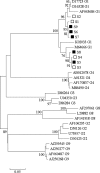Real-time reverse transcription-PCR for detection of rotavirus and adenovirus as causative agents of acute viral gastroenteritis in children
- PMID: 16954246
- PMCID: PMC1594742
- DOI: 10.1128/JCM.00915-06
Real-time reverse transcription-PCR for detection of rotavirus and adenovirus as causative agents of acute viral gastroenteritis in children
Abstract
Viral pathogens are the most common cause of gastroenteritis in developed countries. Human rotavirus and adenovirus infections are major causes of acute outbreaks and sporadic cases of gastroenteritis, occurring primarily among children less than 2 years of age. Patient hospitalization is often required, with enormous infection control implications. This work describes the development of real-time PCR assays for the detection of group F adenovirus, rotavirus A, and rotavirus C from stool specimens. Two hundred twenty stool samples from pediatric patients exhibiting symptoms of diarrhea and/or vomiting were examined. PCR results were compared with those of virus detection by electron microscopy and latex agglutination antigen detection. The incorporation of an internal-control RNA that was spiked into individual stool extracts functioned as an internal validation for the reporting of PCR-negative results. Rotavirus C was not detected by real-time PCR in the patient stool samples examined. Real-time reverse transcription-PCR resulted in 175% and 111% increases in the rates of detection of adenovirus F and rotavirus A, respectively, compared with latex agglutination testing. Molecular detection increased the number of stool specimens in which causative agents of gastroenteritis were identified by 155% compared to electron microscopy. Genotyping of a proportion of the rotavirus and adenovirus strains identified only genotype G1 rotavirus and both adenovirus genotypes 40 and 41 in circulation within the patient cohort examined. The results highlight the significance of rapid molecular methods for the routine screening of stool samples in hospital laboratories to provide rapid definitive diagnoses.
Figures

Similar articles
-
[Investigation of rotavirus, adenovirus and astrovirus frequencies in children with acute gastroenteritis and evaluation of epidemiological features].Mikrobiyol Bul. 2010 Oct;44(4):571-8. Mikrobiyol Bul. 2010. PMID: 21063969 Turkish.
-
Evaluation of a multiplex real time reverse transcription PCR assay for the detection and quantitation of the most common human rotavirus genotypes.J Virol Methods. 2012 Mar;180(1-2):49-53. doi: 10.1016/j.jviromet.2011.12.009. Epub 2012 Jan 11. J Virol Methods. 2012. PMID: 22245180
-
Molecular and epidemiological trend of rotavirus infection among infants and children in Japan.Infect Genet Evol. 2009 Sep;9(5):955-61. doi: 10.1016/j.meegid.2009.06.017. Epub 2009 Jun 26. Infect Genet Evol. 2009. PMID: 19560560
-
[Adenoviruses from stool samples in hospital units. Comparison with main pathogens in gastroenteritis (rotavirus, Campylobacter, Salmonella)].Pathol Biol (Paris). 1995 Sep;43(7):601-10. Pathol Biol (Paris). 1995. PMID: 8570265 Review. French.
-
Rotavirus.Clin Lab Med. 2015 Jun;35(2):363-91. doi: 10.1016/j.cll.2015.02.012. Clin Lab Med. 2015. PMID: 26004648 Review.
Cited by
-
A Novel Automatic Rapid Diagnostic Test Reader Platform.Comput Math Methods Med. 2016;2016:7498217. doi: 10.1155/2016/7498217. Epub 2016 Apr 14. Comput Math Methods Med. 2016. PMID: 27190549 Free PMC article.
-
Frequency of rotavirus and adenovirus gastroenteritis among children in shiraz, iran.Iran Red Crescent Med J. 2013 Aug;15(8):729-33. doi: 10.5812/ircmj.4415. Epub 2013 Aug 5. Iran Red Crescent Med J. 2013. PMID: 24578843 Free PMC article.
-
Rotavirus Diarrhea among Children in Taiz, Yemen: Prevalence-Risk Factors and Detection of Genotypes.Int J Pediatr. 2014;2014:928529. doi: 10.1155/2014/928529. Epub 2014 Aug 12. Int J Pediatr. 2014. PMID: 25197286 Free PMC article.
-
Molecular epidemiology of genogroup II noroviruses infection in outpatients with acute gastroenteritis in Nanjing, China (2010-2013).Biomed Res Int. 2014;2014:620740. doi: 10.1155/2014/620740. Epub 2014 Jul 15. Biomed Res Int. 2014. PMID: 25133173 Free PMC article.
-
Molecular investigations on the prevalence and viral load of enteric viruses in pigs from five European countries.Vet Microbiol. 2016;182:75-81. doi: 10.1016/j.vetmic.2015.10.019. Epub 2015 Oct 21. Vet Microbiol. 2016. PMID: 26711031 Free PMC article.
References
-
- DiStefano, D. J., N. Kraiouchkine, L. Mallette, M. Maliga, G. Kulnis, P. M. Keller, H. F. Clark, and A. R. Shaw. 2005. Novel rotavirus VP7 typing assay using a one-step reverse transcriptase PCR protocol and product sequencing and utility of the assay for epidemiological studies and strain characterization, including serotype subgroup analysis. J. Clin. Microbiol. 43:5876-5880. - PMC - PubMed
-
- Gunson, R. N., J. Miller, A. Leonard, and W. F. Carman. 2003. Importance of PCR in the diagnosis and understanding of rotavirus illness in the community. Commun. Dis. Public Health 6:63-65. - PubMed
-
- Higgins, D. G., and P. M. Sharp. 1988. CLUSTAL: a package for performing multiple sequence alignment on a microcomputer. Gene 73:237-244. - PubMed
-
- Higgins, D. G., J. D. Thompson, and T. J. Gibson. 1996. Using CLUSTAL for multiple sequence alignments. Methods Enzymol. 266:383-402. - PubMed
-
- Hung, T., G. M. Chen, C. G. Wang, H. L. Yao, Z. Y. Fang, T. X. Chao, Z. Y. Chou, W. Ye, X. J. Chang, S. S. Den, et al. 1984. Waterborne outbreak of rotavirus diarrhoea in adults in China caused by a novel rotavirus. Lancet i:1139-1142. - PubMed
Publication types
MeSH terms
Substances
LinkOut - more resources
Full Text Sources
Other Literature Sources
Medical

